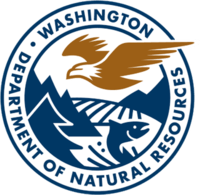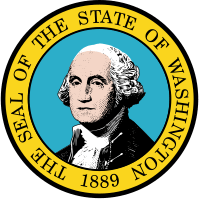Washington State Department of Natural Resources
The Washington State Department of Natural Resources (DNR) manages over 3,000,000 acres (12,000 km2) of forest, range, agricultural, and commercial lands in the U.S. state of Washington. The DNR also manages 2,600,000 acres (11,000 km2) of aquatic areas which include shorelines, tidelands, lands under Puget Sound and the coast, and navigable lakes and rivers. Part of the DNR's management responsibility includes monitoring of mining cleanup, environmental restoration, providing scientific information about earthquakes, landslides, and ecologically sensitive areas. DNR also works towards conservation, in the form of Aquatic Reserves such as Maury Island and in the form of Natural Area Preserves like Mima Mounds or Natural Resource Conservation Areas like Woodard Bay Natural Resource Conservation Area.
 | |
| Department overview | |
|---|---|
| Formed | 1957[1] |
| Preceding agencies |
|
| Type | Environmental agency |
| Jurisdiction | State of Washington |
| Headquarters | Natural Resources Building 1111 Washington Street SE Olympia, Washington 47.0373103°N 122.8977029°W |
| Department executive |
|
| Website | www |
The Department was created in 1957 to manage state trust lands for the people of Washington. DNR management of state-owned forests, farms, rangeland, aquatic, and commercial lands generates more than $200 million in annual revenue for public schools, state institutions, and county services.[2] DNR is also Washington's largest firefighting force, with more than 1,500 firefighters who control wildland fires for more than 13 million acres of private and state-owned forest lands.[3]
The main sources of funds for the department's activities are forestry and geoduck harvesting, rather than taxes. In addition, the State uses revenue generated from DNR-managed lands to fund the construction of public schools, colleges, universities, and other government institutions, and county and state services.
Commissioner of Public Lands
The head of DNR is an elected official, referred to as the Commissioner of Public Lands. Fourteen individuals have served the State of Washington as the Commissioner of Public Lands, two of whom (Taylor and Case) served non-consecutive terms.[4] Otto A. Case also served as Washington State Treasurer from 1933–1937 and 1941–1945. The Commissioner of Public Lands is seventh in the line of succession to the office of Governor of Washington, immediately after the Superintendent of Public Instruction.[5] The current Commissioner of Public Lands is Hilary Franz, who was elected on November 8, 2016.
| Name | Party | Dates Served | |
|---|---|---|---|
| 1 | William T. Forrest | Republican | 1889–1897 |
| 2 | Robert Bridges | Populist | 1897–1901 |
| 3 | S.A. Callvert | Republican | 1901–1905 |
| 4 | E.W. Ross | Republican | 1905–1913 |
| 5 | Clark V. Savidge | Republican | 1913–1933 |
| 6 | A.C. Martin | Democratic | 1933–1941 |
| 7, 9 | Jack Taylor | Democratic | 1941–1945; 1949–1953 |
| 8, 10 | Otto A. Case | Democratic | 1945–1949; 1953–1957 |
| 11 | Bert Cole | Democratic | 1957–1981 |
| 12 | Brian Boyle | Republican | 1981–1993 |
| 13 | Jennifer Belcher | Democratic | 1993–2001 |
| 14 | Doug Sutherland | Republican | 2001–2009 |
| 15 | Peter J. Goldmark | Democratic | 2009–2016 |
| 16 | Hilary Franz | Democratic | 2016–present |
Divisions
- Aquatic Resources
- Conservation, Recreation, and Transactions
- Engineering and General Services
- Financial Management
- Forest Practices
- Forest Resources
- Geology and Earth Resources (often abbreviated as "DGER")[6]
- Human Resources
- Information Technology
- Product Sales and Leasing
Management of public lands
Aquatic reserves
The Department of Natural Resources has established aquatic reserves throughout the state to protect important native ecosystems on state-owned aquatic lands. Through its aquatic reserves, DNR promotes the preservation, restoration, and enhancement of state-owned aquatic lands that are of special educational, scientific, or environmental interest. Managing aquatic reserves does not affect private or other adjacent land ownership.[7]
Law enforcement
DNR employs approximately 10 law enforcement officers who are located throughout the state. These officers patrol lands owned or managed by the DNR. DNR officers are full-authority law enforcement officers while they are on DNR lands. Under state law DNR officers are considered to be limited authority law enforcement officers since their state law enforcement authority is only applicable on lands owned by DNR. The majority of the county sheriffs in Washington have commissioned all of their local DNR officers as county deputies allowing them to act as a full authority law enforcement officer throughout the county, not only on DNR lands. DNR officers are dispatched by the Washington State Patrol.
Natural hazards
The DNR maintains a portal with natural hazard information for the public including tsunamis; landslides and earthquakes; volcanoes and lahars; and "mineral hazards" (asbestos, heavy metals and naturally occurring uranium, and radon gas) in the State of Washington.[8][9]
References
- Wilma, David (February 25, 2003). "Washington legislature creates the Department of Natural Resources in 1957". HistoryLink. Retrieved September 2, 2015.
- "About the Washington Department of Natural Resources". Washington State Department of Natural Resources. Retrieved November 28, 2018.
- "Wildfire Resources". Washington State Department of Natural Resources. Retrieved November 28, 2018.
- Washington State Yearbook: The Evergreen State Government Directory. Olympia, WA: Washington Roll Call. 2017.
- "Washington State Constitution". Washington State Legislature. Retrieved August 23, 2019.
- "Inventory of Geothermal Resources in Washington State". National Park Service. Retrieved May 4, 2019.
- "Aquatic Reserves". Washington State Department of Natural Resources. Retrieved November 28, 2018.
- Haglund, Noah (January 16, 2017). "Spurred by Oso landslide, Washington puts maps online to show areas at risk". The Everett Herald – via The Seattle Times.
- "Geologic Hazards and the Environment". Washington State Department of Natural Resources. Retrieved March 5, 2018.
